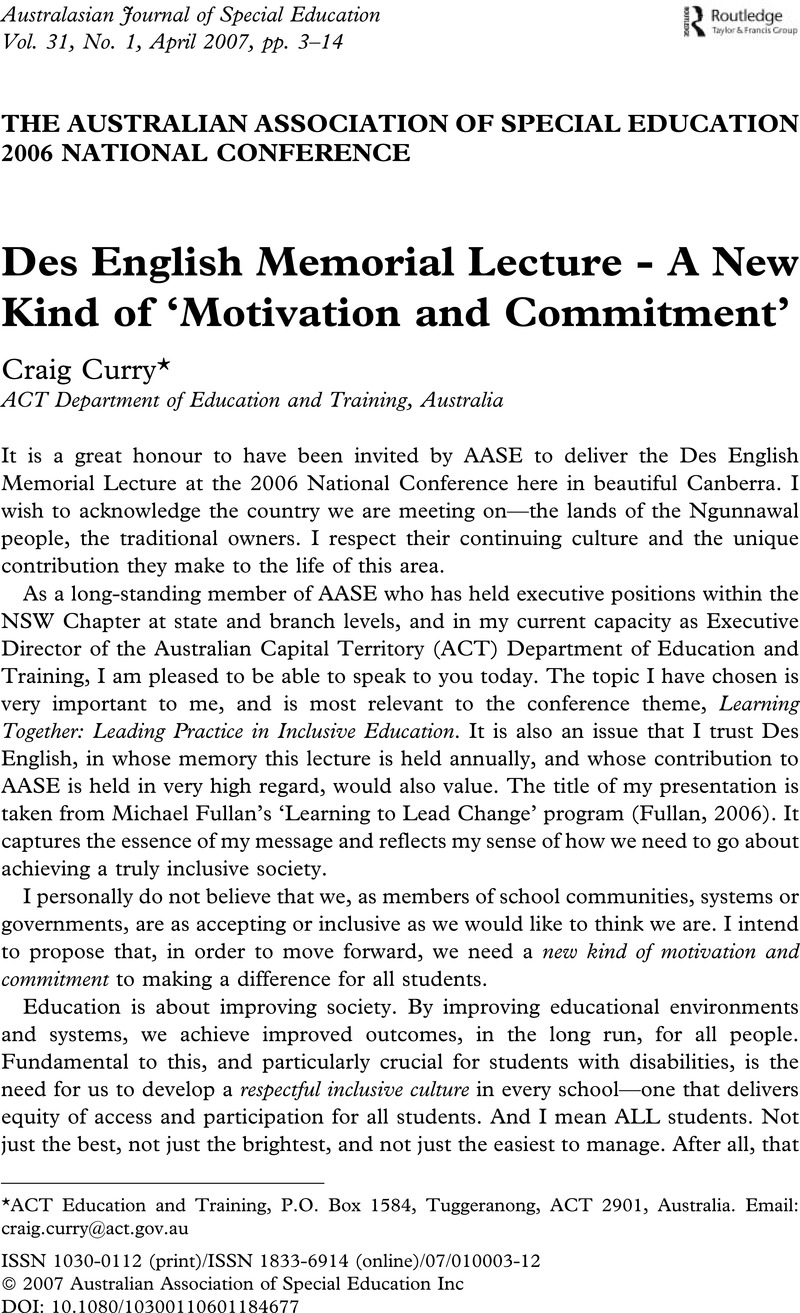No CrossRef data available.
Article contents
Des English Memorial Lecture ‐ A New Kind of ‘Motivation and Commitment’
Published online by Cambridge University Press: 26 February 2016
Abstract
An abstract is not available for this content so a preview has been provided. Please use the Get access link above for information on how to access this content.

- Type
- Articles
- Information
- Copyright
- Copyright © The Australian Association of Special Education 2007
References
ACT Department of Education and Training (2005). Teachers: The key to student success. Canberra, Australia: ACT.Google Scholar
ACT Department of Education and Training (2006a). Curriculum framework for ACT schools. Canberra, Australia: ACT.Google Scholar
ACT Department of Education and Training (2006b). Student centered appraisal of need: Booklet for parents, carers and staff. Canberra, Australia: ACT.Google Scholar
ACT Department of Education and Training (2006c). Towards 2020: Renewing our schools. Canberra, Australia: ACT.Google Scholar
Australian Capital Territory (2004a). Education Act 2004 A2004-17. Canberra, Australia: ACT Parliamentary Counsel.Google Scholar
Australian Capital Territory (2004b). Building our community—the Canberra social plan (2004). Canberra, Australia: ACT.Google Scholar
Australian Capital Territory Government (2004). Future Directions Framework for the ACT (2004-08). Canberra, Australia: ACT.Google Scholar
Australian Government (1992). Disability Discrimination Act. Canberra, Australia: ACT.Google Scholar
Australian Government (2005). Disability Standards for Education. Canberra, Australia: ACT.Google Scholar
Beare, H. (2003). The school of the future. In Davies, B., & West-Burnham, J. (Eds.), Handbook of leadership and management (pp. 635–643). London: Pearson Longman.Google Scholar
Clayton, M. (1996). Clearing the way for inclusion: A response to Thorley, Hotchkis and Martin. Special Education Perspectives, 5, 39–44.Google Scholar
Connors, L. (2006). Shaping the future of public education: Public education—looking in the future. Canberra: ACT Department of Education and Training.Google Scholar
Fullan, M. (2003a). Education in motion: Leading in a culture of change. Swanbourne, Australia: The Centre for Professional Excellence.Google Scholar
Fullan, M. (2003b). The moral imperative of school leadership. Thousand Oaks, CA: Corwin Press.Google Scholar
Fullan, M. (2006). Learning to lead change: Building system capacity. facilitator guide. Hong Kong: Mongkok.Google Scholar
Heifetz, R., & Linsky, M. (2002). Leadership on the line: Staying alive through the dangers of leading. Boston, MA: Harvard Business School Press.Google Scholar
Reitveld, C. (1994). From inclusion to exclusion: Educational placements of children with Down Syndrome. Australasian Journal of Special Education, 18, 28–35.Google Scholar
Wheldall, K. (1994). Why do contemporary special educators favour a non-categorical approach to teaching?
Special Education Perspectives, 3, 45–47.Google Scholar




